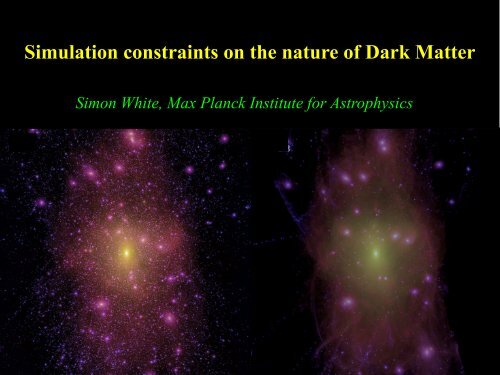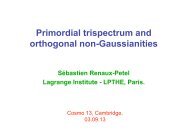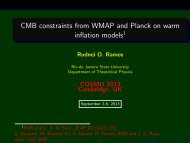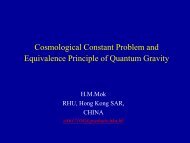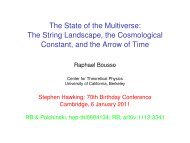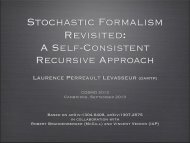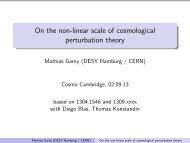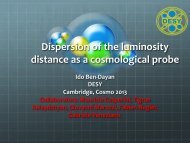Simulation constraints on the nature of Dark Matter - Centre for ...
Simulation constraints on the nature of Dark Matter - Centre for ...
Simulation constraints on the nature of Dark Matter - Centre for ...
You also want an ePaper? Increase the reach of your titles
YUMPU automatically turns print PDFs into web optimized ePapers that Google loves.
<str<strong>on</strong>g>Simulati<strong>on</strong></str<strong>on</strong>g> <str<strong>on</strong>g>c<strong>on</strong>straints</str<strong>on</strong>g> <strong>on</strong> <strong>the</strong> <strong>nature</strong> <strong>of</strong> <strong>Dark</strong> <strong>Matter</strong><br />
Sim<strong>on</strong> White, Max Planck Institute <strong>for</strong> Astrophysics
The first N-body simulati<strong>on</strong>s <strong>of</strong> cosmic structure growth
The first N-body simulati<strong>on</strong>s <strong>of</strong> cosmic structure growth
The first N-body simulati<strong>on</strong>s <strong>of</strong> cosmic structure growth
Efstathiou & Eastwood 1981<br />
Structure <strong>for</strong>mati<strong>on</strong> simulati<strong>on</strong>s<br />
by <strong>the</strong> early 1980s<br />
Methods developed to<br />
treat periodic “boxes” and<br />
larger particle numbers.<br />
Studies still focused <strong>on</strong><br />
n<strong>on</strong>linear growth from<br />
idealized scale-free IC's...
Klypin & Shandarin 1983<br />
Structure <strong>for</strong>mati<strong>on</strong> simulati<strong>on</strong>s<br />
by <strong>the</strong> early 1980s<br />
Methods developed to<br />
treat periodic “boxes” and<br />
larger particle numbers.<br />
Studies still focused <strong>on</strong><br />
n<strong>on</strong>linear growth from<br />
idealized scale-free IC's...<br />
....or from scale-free IC's<br />
with a sharp high cut-<strong>of</strong>f<br />
at high frequencies
Klypin & Shandarin 1983<br />
Structure <strong>for</strong>mati<strong>on</strong> simulati<strong>on</strong>s<br />
by <strong>the</strong> early 1980s<br />
Methods developed to<br />
treat periodic “boxes” and<br />
larger particle numbers.<br />
Studies still focused <strong>on</strong><br />
n<strong>on</strong>linear growth from<br />
idealized scale-free IC's...<br />
....or from scale-free IC's<br />
with a sharp high cut-<strong>of</strong>f<br />
at high frequencies
Calculati<strong>on</strong> <strong>of</strong> precise linear IC's <strong>for</strong> particle DM<br />
● Lyubimov et al (1980) apparent measurement <strong>of</strong> 30 eV mass <strong>for</strong> ν e<br />
● Boltzmann linear transfer calculati<strong>on</strong>s <strong>for</strong> massive ν's and exotic WIMPs<br />
precise initial c<strong>on</strong>diti<strong>on</strong>s <strong>for</strong> n<strong>on</strong>linear structure <strong>for</strong>mati<strong>on</strong><br />
B<strong>on</strong>d & Szalay<br />
1983<br />
Massive neutrinos<br />
HDM<br />
Massive gravitinos, axi<strong>on</strong>s<br />
WDM, CDM
The exclusi<strong>on</strong> <strong>of</strong> neutrinos as a DM candidate<br />
White, Frenk & Davis 1983<br />
New algorithms to represent ν-<br />
dominated IC's, allowed N-body<br />
explorati<strong>on</strong> <strong>of</strong> n<strong>on</strong>linear growth<br />
First structures were massive<br />
pancakes and filaments in which<br />
galaxies could <strong>for</strong>m<br />
CfA
The exclusi<strong>on</strong> <strong>of</strong> neutrinos as a DM candidate<br />
White, Frenk & Davis 1983<br />
New algorithms to represent ν-<br />
dominated IC's, allowed N-body<br />
explorati<strong>on</strong> <strong>of</strong> n<strong>on</strong>linear growth<br />
CfA<br />
ξ gal<br />
= ξ gal, obs<br />
ξ ν<br />
= ξ gal, obs<br />
First structures were massive<br />
pancakes and filaments in which<br />
galaxies could <strong>for</strong>m<br />
No acceptable combinati<strong>on</strong> <strong>of</strong><br />
cosmological and ν parameters,<br />
Ω, h, n, N ν<br />
, z CF<br />
could produce galaxy clustering<br />
as weak as observed<br />
DM cannot be made <strong>of</strong><br />
any known WIMP
Davis et al 1985<br />
The exclusi<strong>on</strong> <strong>of</strong> neutrinos as a DM candidate<br />
...but a new kind<br />
<strong>of</strong> WIMP could<br />
work well<br />
CDM!<br />
CfA
Planck CMB power spectrum from 2.5 surveys
Planck+ parameters and <strong>the</strong> <strong>nature</strong> <strong>of</strong> DM<br />
At recombinati<strong>on</strong> DM was 84.5 ± 2.5 % <strong>of</strong> all mass, bary<strong>on</strong>s 15.5%<br />
The stars and gas in today's galaxies are a small fracti<strong>on</strong> <strong>of</strong> all bary<strong>on</strong>s<br />
Neutrinos account <strong>for</strong> at most a few percent <strong>of</strong> <strong>the</strong> DM
Precisi<strong>on</strong> simulati<strong>on</strong>s <strong>for</strong> cosmology<br />
● Halo abundances are available<br />
to few percent accuracy over 7<br />
orders <strong>of</strong> magnitude in mass<br />
● Differences in definiti<strong>on</strong> <strong>of</strong><br />
“halo” can shift n(M) by tens <strong>of</strong><br />
percent<br />
Angulo et al 2012<br />
● ~40% <strong>of</strong> DM is not in a halo<br />
with M > 10 8 M ⊙<br />
-- lensing<br />
● Bary<strong>on</strong>ic processes can affect<br />
halo structure
M-XXL<br />
N = 3 x 10 11<br />
L = 4.3 Gpc<br />
Simulates <strong>the</strong><br />
<strong>for</strong>mati<strong>on</strong> <strong>of</strong><br />
~1 billi<strong>on</strong> galaxies<br />
directly<br />
Angulo et al 2012
M-XXL<br />
N = 3 x 10 11<br />
L = 4.3 Gpc<br />
Simulates <strong>the</strong><br />
<strong>for</strong>mati<strong>on</strong> <strong>of</strong><br />
~1 billi<strong>on</strong> galaxies<br />
directly<br />
Results c<strong>on</strong>verge<br />
with Millennium<br />
<strong>for</strong> brighter<br />
galaxies<br />
Angulo et al 2012
Distorti<strong>on</strong>s <strong>of</strong> BAO feature in <strong>the</strong> galaxy populati<strong>on</strong><br />
Small but measurable shifts <strong>for</strong> different selecti<strong>on</strong> methods<br />
Angulo et al 2013
van Daalen et al 2011<br />
Feedback effects in a realistic galaxy <strong>for</strong>mati<strong>on</strong> model affect <strong>the</strong><br />
mass power spectrum at <strong>the</strong> several percent level even at λ ~ 10 Mpc<br />
This poses a problem <strong>for</strong> “precisi<strong>on</strong>” cosmology
All ΛCDM halos look similar<br />
1 .1 Mpc 7.1 Mpc<br />
● Cuspy -- radial density pr<strong>of</strong>iles are fit by NFW/Einasto models<br />
● Triaxial -- equidensity c<strong>on</strong>tours with a/c > 2 are comm<strong>on</strong><br />
● Substructure – mainly at large radii with up to tens <strong>of</strong> percent <strong>of</strong> <strong>the</strong> mass
Mean Aquarius halo<br />
All ΛCDM halos look similar<br />
...but not identical<br />
Gao et al 2012<br />
Springel et al 2008<br />
Mean Phoenix halo<br />
c = c<strong>on</strong>st.<br />
Phoenix Project<br />
Nine cluster halos with<br />
M ~ 10 15 M ⊙<br />
, N ~ 2 10 8<br />
Millennium relati<strong>on</strong><br />
● The scatter in pr<strong>of</strong>ile shape between halos <strong>of</strong> given mass is large<br />
compared to dependence <strong>of</strong> mean shape <strong>on</strong> mass<br />
● The dependence <strong>of</strong> c<strong>on</strong>centrati<strong>on</strong> (mean density annihilati<strong>on</strong><br />
efficiency) <strong>on</strong> mass is significant, but not measured to very low mass
All ΛCDM halos look similar<br />
also in <strong>the</strong>ir substructure<br />
● Galaxy halos have slightly less substructure than cluster halos<br />
● Both have roughly equal total mass in each decade <strong>of</strong> subhalo mass<br />
● Total mass in subhalos <strong>of</strong> any mass is still quite uncertain
● Halo annihilati<strong>on</strong> flux dominated by that from unresolved small halos but<br />
this is nearly uni<strong>for</strong>m over <strong>the</strong> sky<br />
● Flux from <strong>the</strong> Galactic centre dominates that from resolved subhalos by a<br />
large factor, but relative detectability depends critically <strong>on</strong> noise sources
<strong>Dark</strong> matter halos – issues<br />
● Pr<strong>of</strong>iles as predicted<br />
NFW over <strong>the</strong> bulk <strong>of</strong> <strong>the</strong> mass<br />
Central cusps (<strong>nature</strong> <strong>of</strong> DM)
Comparis<strong>on</strong> <strong>of</strong> predicted/observed lensing<br />
Okabe et al 2009<br />
measured lensing<br />
strength<br />
predicted lensing<br />
strength
Mean density pr<strong>of</strong>iles <strong>of</strong> dark halos to large radius<br />
Hayashi & White 2007<br />
Stacked halos from <strong>the</strong><br />
Millennium <str<strong>on</strong>g>Simulati<strong>on</strong></str<strong>on</strong>g><br />
● Fit by an NFW or Einasto<br />
pr<strong>of</strong>ile <strong>on</strong> small scales<br />
● Fit by a biased linear 2-point<br />
correlati<strong>on</strong> functi<strong>on</strong> <strong>on</strong> large<br />
scales<br />
● A sharp transiti<strong>on</strong>!
Comparis<strong>on</strong> <strong>of</strong> predicted/observed lensing<br />
Wang, Mandelbaum et al, in prep.<br />
WMAP7<br />
PRELIMINARY<br />
Stacked weak lensing<br />
signal around Locally<br />
Brightest Galaxies in <strong>the</strong><br />
SDSS/DR7 in bins <strong>of</strong> LBG<br />
stellar mass.<br />
Dashed lines are similarly<br />
selected samples from <strong>the</strong><br />
Guo et al (2013) galaxy<br />
<strong>for</strong>mati<strong>on</strong> simulati<strong>on</strong> <strong>for</strong> a<br />
WMAP7 cosmology<br />
A “no parameters” test!
Comparis<strong>on</strong> <strong>of</strong> predicted/observed lensing<br />
Wang, Mandelbaum et al, in prep.<br />
Planck<br />
PRELIMINARY<br />
Stacked weak lensing<br />
signal around Locally<br />
Brightest Galaxies in <strong>the</strong><br />
SDSS/DR7 in bins <strong>of</strong> LBG<br />
stellar mass.<br />
Dashed lines are similarly<br />
selected samples from <strong>the</strong><br />
Guo et al (2013) galaxy<br />
<strong>for</strong>mati<strong>on</strong> simulati<strong>on</strong> <strong>for</strong> a<br />
Planck cosmology<br />
A “no parameters” test!
Effect <strong>of</strong> changing cosmology <strong>on</strong> structure growth<br />
Scalings needed to adapt <strong>the</strong> MS to changing CMB cosmologies<br />
(see Angulo & White (2010) <strong>for</strong> details <strong>of</strong> <strong>the</strong> scaling method)
<strong>Dark</strong> matter halos – issues<br />
metal-poor<br />
“NFW”<br />
Sculptor (and also Fornax) has<br />
two well defined populati<strong>on</strong>s.<br />
Metal-rich stars are clearly more<br />
centrally c<strong>on</strong>centrated and have<br />
lower velocity dispersi<strong>on</strong> than<br />
metal-poor stars. Assuming<br />
“Core”<br />
metal-rich<br />
M( r 1/2,proj<br />
) = C W<br />
r 1/2,proj<br />
σ 2 l.o.s. / G<br />
with C W<br />
≈ 2.5, Walker &<br />
Penarrubia (2011) exclude NFW<br />
mass distributi<strong>on</strong>s
<strong>Dark</strong> matter halos – issues<br />
SPH simulati<strong>on</strong>s by Zolotov et al (2012) suggest dynamics associated<br />
with star <strong>for</strong>mati<strong>on</strong> may “flatten” cores in more massive dwarfs<br />
Do dSph's have enough stars <strong>for</strong> this to be important
<strong>Dark</strong> matter halos – issues<br />
Strigari et al 2013, in prep.<br />
MP<br />
MR<br />
Sculptor<br />
The counts and dispersi<strong>on</strong> pr<strong>of</strong>iles <strong>of</strong> <strong>the</strong> MR and MP populati<strong>on</strong>s in<br />
Sculptor can be well fit (in a χ 2 sense) as equilibria defined by simple<br />
anisotropic distributi<strong>on</strong> functi<strong>on</strong>s within a single NFW potential.<br />
The required NFW parameters are c<strong>on</strong>sistent with ΛCDM subhalos
<strong>Dark</strong> matter halos – issues<br />
● Pr<strong>of</strong>iles as predicted<br />
NFW over <strong>the</strong> bulk <strong>of</strong> <strong>the</strong> mass<br />
Central cusps (<strong>nature</strong> <strong>of</strong> DM)<br />
● Shapes as predicted<br />
Shapes from lensing (individual clusters stacked galaxies)<br />
Orbits <strong>of</strong> <strong>the</strong> streams in <strong>the</strong> MW or M31 halos
<strong>Dark</strong> matter halos – issues<br />
Matching kinematics <strong>of</strong> both leading and trailing arms <strong>of</strong> Sagittarius<br />
can be accomplished by a potential which is oblate at r > 30kpc. The LMC can have a significant effect.<br />
(Vera-Ciro & Helmi 2013)
<strong>Dark</strong> matter halos – issues<br />
● Pr<strong>of</strong>iles as predicted<br />
NFW over <strong>the</strong> bulk <strong>of</strong> <strong>the</strong> mass<br />
Central cusps (<strong>nature</strong> <strong>of</strong> DM)<br />
● Shapes as predicted<br />
Shapes from lensing (individual clusters stacked galaxies)<br />
Orbits <strong>of</strong> <strong>the</strong> streams in <strong>the</strong> MW or M31 halos<br />
● Substructure as predicted<br />
Effects <strong>on</strong> disk GCs Streams<br />
Effects <strong>on</strong> str<strong>on</strong>gly lensed background objects<br />
Satellite counts – abundances, M *<br />
–V max<br />
relati<strong>on</strong>s
<strong>Dark</strong> matter halos – issues<br />
Carlberg, Grillmair & He<strong>the</strong>ringt<strong>on</strong> 2013<br />
Gaps in <strong>the</strong> Pal 5 star stream may be induced by DM subhalos<br />
Five gaps at >99% c<strong>on</strong>fidence requires >1000 substructures within<br />
30 kpc with V max<br />
> 1 km/s, c<strong>on</strong>sistent with ΛCDM predicti<strong>on</strong>s.
A “Milky Way” halo in CDM and WDM (a “2.3 keV” sterile ν)<br />
A mass exceeding ~1.5 keV is needed to get enough satellites<br />
<strong>Dark</strong> matter halos – issues<br />
Lovell et al 2013.<br />
CDM<br />
WDM
Subhalo density pr<strong>of</strong>iles in WDM vs CDM<br />
Lovell et al 2013.<br />
2.3<br />
2.0<br />
1.6<br />
1.4<br />
WDM (sub)halos do NOT have cores. They are cuspy, as in CDM, but<br />
<strong>the</strong>y are less c<strong>on</strong>centrated. WDM cannot explain dwarf galaxy cores
Subhalo density pr<strong>of</strong>iles in WDM vs CDM<br />
Lovell et al 2013.<br />
Lower c<strong>on</strong>centrati<strong>on</strong> leads to lower characteristic velocity at given<br />
subhalo mass<br />
could help explain <strong>the</strong> low stellar velocities<br />
in (most) Milky Way dwarf satellites (<strong>the</strong> “too big to fail” problem)
Structure in pregalactic gas at high redshift<br />
McD<strong>on</strong>ald et al 2005<br />
Diffuse intergalactic gas<br />
at high redshift can be<br />
observed through its Ly α<br />
absorpti<strong>on</strong> in QSO spectra<br />
Transmissi<strong>on</strong> power spectrum<br />
z=4.2<br />
Structure in <strong>the</strong> absorpti<strong>on</strong><br />
is due to fluctuati<strong>on</strong>s in <strong>the</strong><br />
density and gravitati<strong>on</strong>ally<br />
induced velocity<br />
Data - 3300 SDSS quasars<br />
Model - ΛCDM<br />
model<br />
data<br />
z=2.2<br />
λ ~ 10 Mpc
<strong>Matter</strong> power spectra <strong>for</strong> WDM relative to CDM<br />
Viel, Becker, Bolt<strong>on</strong> & Haehnelt 2013<br />
In linear <strong>the</strong>ory, power in<br />
WDM (assuming <strong>the</strong>rmal<br />
relics) is half that in CDM at<br />
N<strong>on</strong>linear effects transfer<br />
power to small scales and<br />
weaken <strong>the</strong> cut-<strong>of</strong>f.<br />
linear power <strong>for</strong> 2 keV<br />
The effect is already quite<br />
significant by z = 5.4<br />
At given k, suppressi<strong>on</strong> is<br />
str<strong>on</strong>gest at high redshift
Lyman α <strong>for</strong>est spectra <strong>for</strong> WDM relative to CDM<br />
Viel, Becker, Bolt<strong>on</strong> & Haehnelt 2013<br />
z = 4.6<br />
Transmitted quasar flux in hydrodynamic simulati<strong>on</strong>s <strong>of</strong> <strong>the</strong> intergalactic<br />
medium in ΛCDM and WDM models.<br />
High-frequency power is missing in <strong>the</strong> WDM case
Lyman α <strong>for</strong>est spectra <strong>for</strong> WDM relative to CDM<br />
Viel, Becker, Bolt<strong>on</strong> & Haehnelt<br />
2013<br />
High-resoluti<strong>on</strong> Keck<br />
and Magellan spectra<br />
match ΛCDM up to<br />
z = 5.4<br />
This places a 2σ lower<br />
limit <strong>on</strong> <strong>the</strong> mass <strong>of</strong> a<br />
<strong>the</strong>rmal relic<br />
m WDM<br />
> 3.3 keV<br />
This lower limit is too<br />
large <strong>for</strong> WDM to have<br />
a significant effect <strong>on</strong><br />
dwarf galaxy cores
Future simulati<strong>on</strong> <str<strong>on</strong>g>c<strong>on</strong>straints</str<strong>on</strong>g> <strong>on</strong> DM/DE<br />
● C<strong>on</strong>straints <strong>on</strong> annihilati<strong>on</strong><br />
-- structure, abundance and spatial distributi<strong>on</strong> <strong>of</strong> low-mass halos<br />
-- <strong>for</strong>mati<strong>on</strong> <strong>of</strong> “dark stars”<br />
● Collisi<strong>on</strong>al DM<br />
-- “bullet” clusters, halos <strong>of</strong> cluster galaxies, MW satellites<br />
-- shapes <strong>of</strong> halos (x-ray imaging, lensing)<br />
● DM/DE interacti<strong>on</strong>s<br />
-- fifth <strong>for</strong>ce effects (different effective G <strong>for</strong> bary<strong>on</strong>s/DM)<br />
-- variable DM particle mass, “decay” <strong>of</strong> DM into DE<br />
● DE-<strong>on</strong>ly effects<br />
-- modificati<strong>on</strong> <strong>of</strong> halo assembly histories/density pr<strong>of</strong>iles<br />
-- quasi-linear/n<strong>on</strong>linear redshift-space distorti<strong>on</strong> <strong>of</strong> <strong>the</strong> density field
Take away messages<br />
● Neutrino DM was ruled out by simulati<strong>on</strong>s as so<strong>on</strong> as <strong>the</strong> linear<br />
cosmological IC's could be calculated ab initio and represented<br />
numerically, but CDM has been rein<strong>for</strong>ced as simulati<strong>on</strong>s improve<br />
● Current simulati<strong>on</strong>s <strong>of</strong> <strong>the</strong> n<strong>on</strong>linear DM distributi<strong>on</strong> are limited<br />
primarily by uncertainties in <strong>the</strong> treatment <strong>of</strong> bary<strong>on</strong> effects<br />
● Apparent small-scale discrepancies with ΛCDM do not have <strong>the</strong><br />
character expected <strong>for</strong> WDM, and Lyman α <strong>for</strong>est data now exclude<br />
WDM models which would significantly affect dwarf galaxies<br />
● Many more complex variati<strong>on</strong>s in DM properties have still been<br />
explored too little to fully determine <strong>the</strong>ir viability/interest


